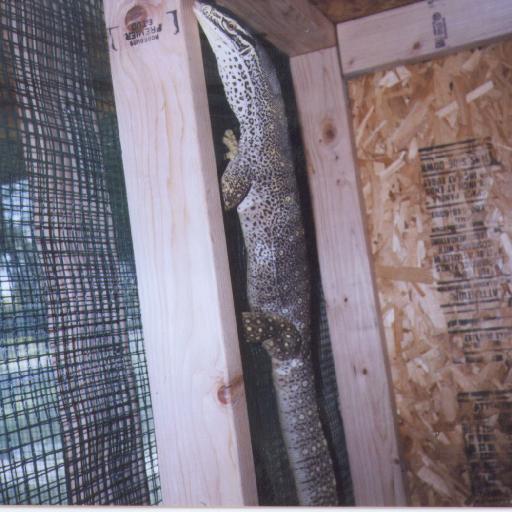
This picture shows the form and coloration of a typical New Guinea argus monitor.
This section is copied in part from an answer to a question I received over e-mail. I have been asked this question several times so I thought I'd post it here for everyone's reference.
The scientific name of the argus monitor has been changed a couple times in the last two decades. This, understandably, leads to considerable confusion in what to call it. Up until the middle of this century, there was considered to be a species of monitor called Varanus gouldii, commonly known as the sand monitor, that ranged across all of Australia and parts of New Guinea. Then, someone figured out that the melanistic southern form was a different, but closely related, species, called Varanus rosenbergii, or the heath monitor. In 1980, Varanus gouldii was split again, this time separating off the strongly yellow spotted form from northern Australia and New Guinea from the lighter, more complexly patterned forms. The yellow spotted form was called Varanus panoptes, the argus monitor, while the other forms remained Varanus gouldii, the sand monitor. This was all fine up until around the middle of this decade, when someone found out that the museum specimen that was apparently the type specimen of Varanus gouldii was actually the species being called Varanus panoptes. By the rules of scientific nomenclature, this meant that the species formerly known as Varanus panoptes actually was Varanus gouldii, and the sand monitor was something else, soon named Varanus flavirufus. Things quickly got confusing, however, since the museum specimen was not actually the type, but rather the paratype (a distinction which even I don't fully understand). The whole affair went up before the committee that decides the scientific names of animals (the International Commission on Zoological Nomenclature, or ICZN for short). They formally decided that the argus monitor was Varanus panoptes, and so it will remain, now and forever. The desert dwelling sand monitors remain Varanus flavirufus, since they are a different species from what was originally formally described, and yet another species retains the name Varanus gouldii. This is all rather confusing, and it takes a while for everyone to catch up to the name change, however, so some people are still calling arguses Varanus gouldii. With time, the new names will gain acceptance until they are more nearly universally used.
There are currently three recognized subspecies of argus monitor. The New Guinea argus, Varanus panoptes hornii, is common in the pet trade in U.S.A. and Europe. The only readily identifiable feature that distinguishes it from the northern Australian argus monitor Varanus panoptes panoptes is its geographic distribution and its slightly smaller size. V. p. panoptes is supposed to be a very large monitor, sometimes rivaling the lace monitors and perenties in size. There is a smaller argus monitor from western Australia that goes by the scientific name Varanus panoptes rubidus. This subspecies can be distinguished from the others because its tail is not banded on the last third or so of its length, all other argus monitors have banding down to the very tip.
Argus monitors are sometimes called yellow spotted monitors. In Australia, they are apparently also often called sand goannas along with Varanus flavirufus, Varanus gouldii, and Varanus rosenbergii. To confuse matters further, Varanus flavirufus and Varanus panoptes are sometimes called the Gould's monitor, especially in older publications. A current trend that is emerging among the scientific and herpetocultural community is to reserve the common name argus monitor only for the New Guinea variety of Varanus panoptes. The giant Australian Varanus panoptes panoptes and the arid-dwelling Varanus panoptes rubidus are referred to as yellow spotted monitors. This is a useful distinction, but for convenience, I'm using the term argus monitor to refer to all Varanus panoptes in this text for lack of a better common name for the species as a whole. In America and English speaking Europe, the name sand monitor generally applies only to Varanus flavirufus in spite of the Australians. The species Varanus rosenbergii is usually called the heath monitor or Rosenberg's monitor. Only Varanus gouldii proper should really be called the Gould's monitor, but that will not stop people from using that term for other monitors.
So how do you know what type of monitor that is sitting in the pet shop? If you are in the United States, it is almost certainly the New Guinea argus monitor. This is the only subspecies that is commonly available over here. Australia does not allow any of its native wildlife to be exported. There are a few Australian argus monitors in zoos and possibly fewer in private collections, and if these breed more of the Aussi monitors may come in to the American and European market. This is what happened to the sand monitors in the U.S. There are a few sand monitors being captive bred in America, and the offspring are occasionally available, but usually for much higher prices than the argus monitors. If the gouldii complex monitor you are looking at has a color pattern similar to those pictured on this page, it is probably a New Guinea argus.

This picture shows the form and coloration of a typical
New Guinea argus monitor.